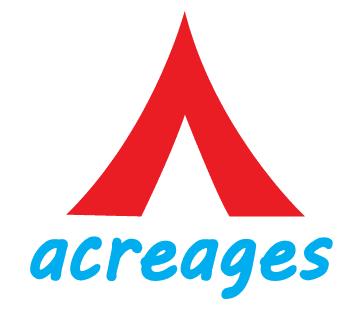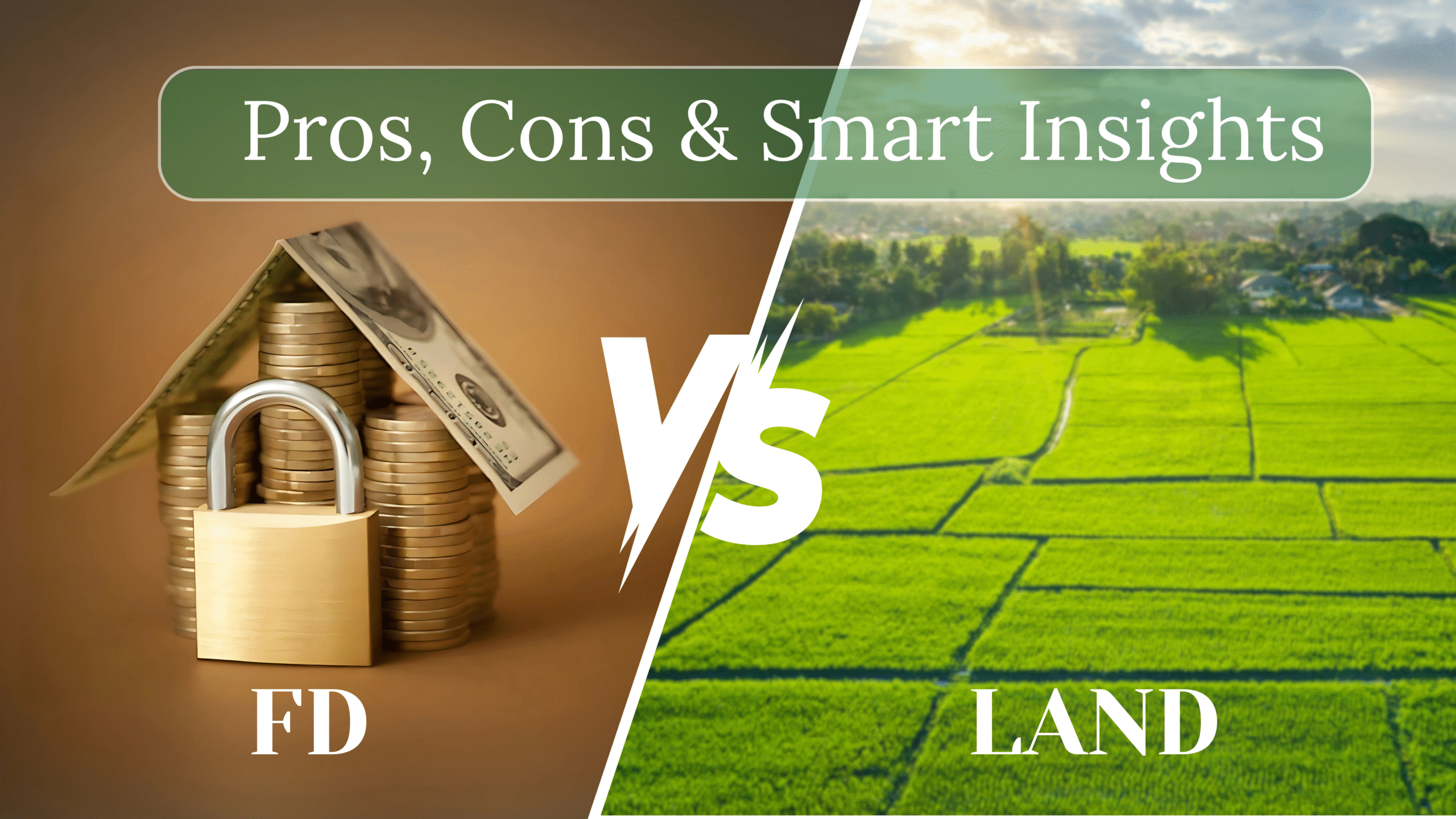In today’s ever-changing financial landscape, choosing the right investment vehicle is one of the most critical decisions an individual can make. Traditionally, Indians have relied on two prominent forms of investment for long-term wealth creation and financial security — Fixed Deposits (FDs) and Land Investments. Both of these are deeply rooted in our economic culture but serve very different purposes.
A Fixed Deposit is often seen as a “safe” investment option where your money earns a fixed interest over time, giving you peace of mind about guaranteed returns. On the other hand, land is regarded as a tangible, appreciating asset that not only preserves capital but also grows exponentially in value with time, depending on the location and development around it.
While FDs appeal to conservative investors seeking stability, land investments attract those who are looking for growth, wealth creation, and legacy. But in the modern world — where inflation, lifestyle changes, and financial goals are reshaping how we perceive money — the question arises: Which one is truly better for building long-term wealth?
To answer this, let’s compare FD vs Land across multiple dimensions in depth.
Comparison Points: FD vs Land Investment
🔹 1. Legacy and Emotional Value
- FD: FDs are liquid and transferable but rarely hold emotional or legacy value. Once withdrawn, the money is spent and forgotten.
- Land: Land carries immense emotional and legacy value. Families pass down land across generations, and it often becomes a symbol of security, pride, and belonging — something an FD can never provide.
🔹 2. Enjoyment of Investment
- FD: FD is purely financial; you cannot “enjoy” it beyond the numbers in your bank account. It remains invisible until maturity.
- Land: With land, you can actually use and enjoy your investment. You can build a farmhouse, use it for weekend getaways, lease it for farming, or hold it as your family’s future home. This makes land a more “living investment” compared to the passive nature of FDs.
🔹 3. Wealth Creation Potential
- FD: FD grows money safely but slowly. It can never turn you into a millionaire by itself unless you invest a massive lump sum for decades.
- Land: Land has multi-generational wealth creation potential. A single piece of land bought in the right area can change the financial destiny of an entire family. Unlike FDs, it not only appreciates but can also be developed into houses, rental property, or commercial spaces for active income generation.
🔹 4. Return on Investment (ROI)
- FD: Fixed Deposits typically offer 5–7% interest per annum in India, depending on the bank and tenure. While the returns are predictable, they are relatively low, especially when compared to inflation (which averages around 5–6%). This means, in real terms, the money might not grow significantly in value.
- Land: Land investments often yield exponential appreciation over time. A strategically located plot can appreciate by 500–900% within a decade, especially if infrastructure projects (roads, highways,tourism, metro, industrial zones) come up nearby. Unlike FDs, land appreciation isn’t capped — it can grow boundlessly with demand.
🔹 5. Inflation Hedge
- FD: Since FD interest rates barely match inflation, the purchasing power of your money remains almost stagnant. If inflation is higher than the FD rate, you’re essentially losing value over time.
- Land: Land is a natural hedge against inflation. As the cost of living rises, so does the demand and price of land. Historically, land has always appreciated faster than inflation, thereby safeguarding and increasing real wealth.
🔹 6. Liquidity
- FD: One of the strongest advantages of FDs is their liquidity. You can break an FD anytime (with a small penalty) and access your funds almost instantly. This makes it suitable for emergencies or short-term needs.
- Land: Land, on the other hand, is a less liquid asset. Selling a plot may take weeks, months, or even longer, depending on market conditions. However, the trade-off for lesser liquidity is much higher growth potential.
🔹 7. Risk Factor
- FD: Practically risk-free since it’s backed by banks and regulated by the RBI. Even if a bank defaults, deposits up to ₹5 lakhs are insured by DICGC. So, there is very little risk.
- Land: Land carries risks like legal disputes, unclear titles, or delays in finding the right buyer. However, with proper due diligence, clear paperwork, and investing in developing areas, these risks can be minimized — and the growth potential far outweighs the risk.
🔹 8. Tax Benefits
- FD: Interest earned on FDs is fully taxable as per your income slab. This reduces the net effective returns, especially for those in higher tax brackets.
- Land: Land does not generate taxable income unless sold. Long-term capital gains tax applies when you sell (with indexation benefits), which often results in more favorable taxation compared to yearly FD interest.
🔹 9. Impact of Time (Compounding vs Appreciation)
- FD: FDs grow through compounding interest, but growth is capped and predictable. Even after 10–15 years, returns won’t exceed a fixed percentage.
- Land: Land appreciates based on external factors like urbanization, infrastructure, and demand. While it doesn’t compound mathematically like FDs, it multiplies unpredictably — often at rates far higher than FD compounding.
🔹 10. Accessibility and Entry Barrier
- FD: Very easy to start. You can open an FD with as little as ₹5,000, making it accessible to anyone.
- Land: Requires a larger initial investment, usually in lakhs, and proper documentation. However, the long-term benefits justify the higher entry barrier.
🔹 11. Control over Investment
- FD: Once invested, your control is limited. The bank decides the interest rate, and you cannot influence growth.
- Land: With land, you have full control. You can sell, lease, develop, or hold, depending on your financial strategy. Your decision directly impacts the wealth potential.
🔹 12. Safety vs Growth Trade-off
- FD: Best suited for conservative investors, retirees, or those who value safety and liquidity over growth.
- Land: Best suited for long-term investors who want growth, appreciation, and wealth creation, even if it means waiting longer.
Conclusion
Both Fixed Deposits (FDs) and Land Investments play important roles in an investor’s portfolio — but they serve different purposes. FDs offer safety, liquidity, and predictability, making them ideal for emergencies, retirees, or short-term savings. However, they fail to beat inflation, lack wealth creation power, and provide no emotional or lifestyle value.
Land, on the other hand, is an appreciating asset that not only grows exponentially with time but also offers a sense of security, legacy, and enjoyment. While it requires a larger entry cost and comes with risks like paperwork and liquidity, the long-term benefits far outweigh the downsides. A single well-bought piece of land can secure multiple generations financially, something an FD simply cannot match.
In simple terms — FDs are like a safety locker, while Land is like a treasure chest. One protects your money, the other grows it into wealth. For a truly balanced financial life, it’s wise to keep a mix of both: FDs for safety and emergencies, and Land for wealth creation and legacy building.
Acreages
Already, hundreds of families are enjoying their dream weekend homes with us. Come, be a part of this ever-growing community where nature, peace, and trust flourish.
For more details, please visit www.acreages.in






